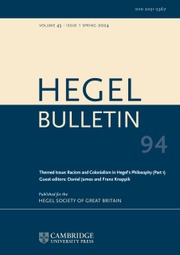Article contents
Conscience and Transgression: The Persistence of Misrecognition
Published online by Cambridge University Press: 23 June 2015
Abstract
The aim of the Phenomenology of Spirit is to provide its reader with a “ladder” to the standpoint of science, showing him “this standpoint within himself (§26). By the standpoint of science, the standpoint of absolute knowing, I understand a perspective in which human cognition has no absolute limits or barriers, in which no items and types of items, most notably Kant's things in themselves, are intrinsically or a priori external to human cognition. Hegel is only attempting to provide a ladder to this standpoint because he believes that no demonstration or deduction of it is possible. Hegel's denial of the possibility of demonstration is premised on a simple logical insight: if what is presupposed as external to reason and cognition – material objects, other persons, language, social practices, history – are in fact constitutive conditions of them, then a position whose premises are weaker than what it seeks to demonstrate, as for example one might attempt to explicate the possibility of linguistic meaning only through reference to elaborate structures of intention, must necessarily fail. Hence, Hegel's initially puzzling formula that states that the “aether” of knowing is “pure self-recognition in absolute otherness” (§26), is designedly anti-Kantian: we only come to apperceptive self-awareness, what for Kant is pure or transcendental self-consciousness, through cogntion of things in themselves, the very things access to which Kant denies as a condition apperception.
- Type
- Hegel's Phenomenology of Spirit
- Information
- Bulletin of the Hegel Society of Great Britain , Volume 15 , Issue 1: number 29 , Spring/Summer 1994 , pp. 55 - 70
- Copyright
- Copyright © The Hegel Society of Great Britain 1994
References
1 All references in the text are to the paragraph number in Phenomenology of Spirit, trans Miller, A V, Oxford: Clarendon Press, 1977 Google Scholar.
2 See, for example, Flay, Joseph C, Hegel's Quest for Certainty, Albany: State University of New York Press, 1984, pp 224 Google Scholar-5.
3 Elements of the Philosophy of Right, trans Nisbet, H B, Cambridge: Cambridge University Press, 1991, §270n (p 295)Google Scholar.
4 On Christianity: Early Theological Writings, trans Knox, T M, New York: Harper Torchbooks 1948, pp 228-9Google Scholar.
5 “Moral Development and Social Struggle: Hegel's Early Social-Philosophical Doctrines”, in Honneth, A, et al (eds), Cultural-Political Interventions in the Unfinished Project of Enlightenment, London and Cambridge, Mass: The MIT Press, 1992, p 212.Google Scholar
6 The claim that Hegel logicizes the causality of fate once he discovers modern political economy is a running theme in Habermas' work that is presumptively used to justify his turn to communicative action. For the relevant passages in Habermas and a critique of his view that communicative action can pick up the fundamentals of the causality of fate see my “The Causality of Fate: Modernity and Modernism in Habermas”, Praxis International, 8/4 (Jan 1989), pp 418–422.Google Scholar
7 Op cit, pp 232-3.
8 Religion Within the Limits of Reason Alone, trans Green, T M and Hudson, H H, New York: Harper Torchbooks, 1960, pp 27–34 Google Scholar. For an excellent discussion of Kant's argument, see Allison, Henry E, Kant's Theory of Freedom, Cambridge: Cambridge University Press, 1990, ch 8CrossRefGoogle Scholar.
9 Ibid, p 19; and for a discussion of this thesis, see Allison, ibid, pp 39-41.
10 The only commentator I am aware of who has seen the discussion of conscience as providing a theory of action is Benjamin C Sax, 'Active Individuality and the Language of Confession: The Figure of the Beautiful Soul in Lehrjahre and the Phänomenologie”, Journal of the History of Philosophy, 21/4 (1983), pp 437–466 CrossRefGoogle Scholar.
11 Situating the Self: Gender, Community and Postmodernism in Contemporary Ethics, Oxford: Polity Press, 1992, p 37 Google Scholar. For Habermas' own discussion of Principle D, see his Moral Consciousness and Communicative Action, trans Lenhardt, C and Nicholsen, S W, Cambridge, Mass: The MIT Press, pp 76–109.Google Scholar
12 A Theory of Justice, Cambridge, Mass: Harvard University Press, 1971, p 422 Google Scholar. For a pertinent discussion of this, see Stanley Cavell, Conditions Handsome and Unhandsome: The Constitution of Emersonian Perfectionism, Chicago and London: The University of Chicago Press, 1990, pp 112-14.
13 The most prominent defender of the reproachability thesis, although he fallaciously confuses it with the different question of the overridingness of moral requirements, is Bernard Williams. See, for example, his Moral Luck, Cambridge: Cambridge University Press, 1981, ch 2Google Scholar.
14 “Fate and Character”, in Reflections: Essays, Aphorisms, Autobiographical Writings, trans Jephcott, E, New York: Harcourt Brace Jovanovich, 1978, p 308 Google Scholar.
15 In putting the matter this way, I mean to leave open the question as to whether or not the reproachability thesis can be read out of the paragraphs where I have located it. If not, then I would need to concede it as simply a logical inference to be drawn from the conjunction of moral fallabilism and interpretive pluralism. Without the reproachability thesis the introduction of expressivity and community is unnecessary, since without it the need to distinguish the moral standing of the agent from the moral value of the acts she performs remains unnecessary. Hence, what I think we must affirm is that Hegel means to urge something like the reproachability thesis as the obvious consequence of defeating the strong version of conscience.
- 2
- Cited by




